Since the September 11 attacks, the attention of Westerners has been drawn to Islam, since we are being told that Osama Bin Laden committed these terrorist attacks in the name of Islamic fundamentalism. While it is true that the vast majority of Moslems condemn violence and these terrorist attacks, a minority of extremist Moslems claim that it is “Allah” who asked them to wage a holy war against “the infidel”.
What is the real face of Islam? Does it preach peace or war? Even if the word “Islam” itself can be defined as “to make peace”, “to surrender”, the truth is that there is a dark side of Islam which, although only put into practice by a small number of extremists, indeed advocates violence. Over the centuries, Muslims have engaged in tremendous wars with Christians and Jews, and Christians are being persecuted and killed by Moslems in many countries today, like Indonesia and Sudan. Is there a way Christians and Moslems can co-exist together in peace?
Mohammed, the founder of the Islam faith, was born in Mecca, Arabia, in 575. An orphan raised by an uncle, he served as a camel caravan leader until the age of 25, when he got married to a wealthy woman who was 15 years older than him, and he became the manager of her fortune. Like the other Arabs of his country, Mohammed did not profess any particular religious creed. Over 300 gods were worshipped in Mecca, among them Allah, the god of the moon. Mohammed liked to talk to strangers, be they Jews or heretical Christians, and used to read their books.
Mohammed then invented a religion of his own – a mixture of his readings – and presented it to his wife and some of his relatives. Only one God, Allah (that is why Islam is represented by the crescent), but several prophets, Abraham, Moses, Jesus, and the last and greatest prophet of all, himself. (According to him, Jesus was not God, but only a prophet, and did not die on the Cross, but was replaced by another person at the last moment.)
The people of Mecca did not accept his religion, and he was forced to flee to Medina in 622, year one of the Moslem faith. There he won over a majority of people to his new religion, and came back to the “holy city” of Mecca with the title of “the great prophet of Allah”. He died there in 632, leaving to his disciples the Koran (the holy book of the Moslems, divided into surahs), which promised a paradise of eternal sensual pleasures to all those who faithfully accomplished the few practices indicated in the Koran, especially to those who would spread Islam by all means... including the sword.
Historians agree to say that there is a big difference between Mohammed's personality in Mecca and his personality after his migration to Medina. In Mecca, Mohammed was struggling to be accepted, so he tried to appeal to Christians and Jews as well, his teachings condemning violence, injustice, and neglect of the poor. However, when he moved to Medina, and his followers grew in strength and number, he no longer needed to please people of other faiths, and became a relentless warrior intent on spreading his religion by the sword.
In Surah 73:10, God tells Mohammed to be patient with his opponents, but later in Surah 2:191, God orders him to kill them. In Surah 2:256, God tells Mohammed not to impose Islam by force (“Let there be no compulsion in religion”); while in verse 193 God tells him to kill whoever rejects Islam. In Surah 29:46, God tells him to speak nicely to people of the Book (Christians and Jews), but in Surah 9:29 God tells him to fight them. To justify this sudden change in the Koran's mood, from peaceful to militant, conciliatory to confrontational, Mohammed claimed that it was God who ordered it. It was God who abrogated the peaceful verses, and replaced them by harsh ones.
To conquer countries with the sword became the password. The Moslems set out in 634 to conquer the world. Within a year, they had captured Syria and Damascus. Three years later, they captured Jerusalem. By 643, they had conquered a territory half the size of Europe. In 711, they crossed the strait of Gibraltar, and rapidly conquered Spain and Portugal, and remained there for seven centuries. In 1571, at the naval Battle of Lepanto, the invasion of Europe by the Moslems was definitely stopped.
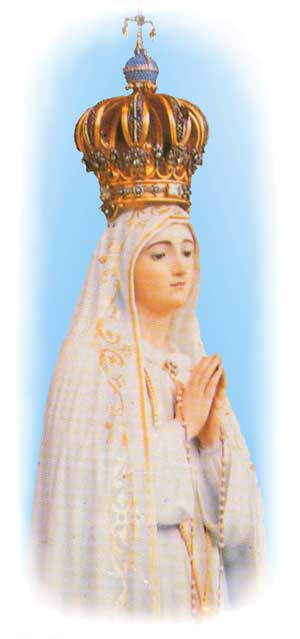 It is extremely difficult for Christian missionaries to convert Moslems, because they think that their religion is the accomplishment of Christianity, because it came after... and of course also because the Koran teaches that any Moslem who converts to another faith must be killed. So those who do convert do it at the risk of their lives, and most of the time, must flee to Western countries.
It is extremely difficult for Christian missionaries to convert Moslems, because they think that their religion is the accomplishment of Christianity, because it came after... and of course also because the Koran teaches that any Moslem who converts to another faith must be killed. So those who do convert do it at the risk of their lives, and most of the time, must flee to Western countries.
In 1952, Catholic Archbishop Fulton Sheen devoted a chapter in his book, “The World's First Love”, entitled “Mary and the Moslems”. In it, he wrote that it is his firm belief that Moslems will eventually be converted in Christianity, thanks to the devotion they already have to the Virgin Mary. In fact, God the Father seems to have a special plan to draw the Moslems to Jesus through His Mother, Mary.
Bishop Sheen wrote: “In the Koran, the Virgin Mary is mentioned thirty times. It believes in Her Immaculate Conception, and also, in Her Virgin Birth. It has also verses on the Annunciation, Visitation, and Nativity. Angels are pictured as accompanying the Blessed Mother and saying: ‘Oh, Mary, God has chosen you and purified you, and elected you above all the women of the earth.’ Mary, then, is for the Moslems the true Sayyida, or Lady. The only possible serious rival to her in their creed would be Fatima, the daughter of Mohammed himself. But after the death of Fatima, Mohammed wrote: ‘Thou shalt be the most blessed of all the women in Paradise, after Mary.’ In a variant of the text, Fatima is made to say, ‘I surpass all the women, except Mary.’
“This brings us to our second point: namely, why the Blessed Mother, in the 20th century should have revealed Herself in the significant little village of Fatima, Portugal, so that to all future generations she would be known as ‘Our Lady of Fatima.’ Since nothing ever happens out of Heaven except with a finesse of all details, I believe that the Blessed Virgin chose to be known as ‘Our Lady of Fatima’ as a pledge and a sign of hope to the Moslem people, and as an assurance that they, who show her so much respect, will one day accept her divine Son too. . . I believe the Blessed Virgin chose to be known by the name Fatima because she also came for the conversion of Islam, without which there cannot be an era of peace for mankind.
“Evidence to support these views is found in the historical fact that the Moslems occupied Portugal for centuries. At the time when they were finally driven out, the last Moslem chief had a beautiful daughter by the name of Fatima. A Catholic boy (the Count of Ourem) fell in love with her, and for him she not only stayed behind when the Moslems left, but even embraced the Catholic Faith. The young husband was so much in love with her that he changed the name of the town where he lived to Fatima. Thus, the very place where our Lady appeared in 1917 bears a historical connection to Fatima, the daughter of Mohammed.”
Alain Pilote
On pages 6-7 of the previous issue of "Michael", in the article "Mary and the Moslems", the signature at the end gave the wrong impression that the whole article was written by Alain Pilote, while in fact, half of the article (beginning from the middle of the 3rd column of page 6 up to the end) was taken directly from Father Cizik's article in SOUL Magazine. We apologize to this excellent Marian periodical. This article was reprinted from SOUL Magazine, September-October 2001: Our Lady and Islam: Heaven's Peace Plan, by Father Ladis J. Cizik, editor. To subscribe, send money order in U.S. currency (Canada 1 yr. $10.95) to: SOUL MAGAZINE, PO Box 976, Washington, NJ 97882-0976. Toll-free: 866-523-1917. Website: www.bluearmy.com
Here is what Father Cizik, editor of the excellent Marian periodical SOUL Magazine, wrote in his Sept.-Oct. 2001 issue: “It is a fact that Moslems from various nations, especially from the Middle East, make so many pilgrimages to the Shrine of Fatima in Portugal that Portuguese officials have expressed concern. The combination of an Islamic name and Islamic devotion ro the Blessed Virgin Mary is a great attraction to Moslems.” (To subscribe to SOUL Magazine, send money order in U.S. currency (Canada 1 year $10.95) to: SOUL Magazine, PO Box 976, Washington, NJ 07882-0976. Toll-free: 866-523-1917.)
This same issue of SOUL reports another proof of the devotion of the Moslems to Our Lady: “When the Moslems invaded the Holy Land in the seventh century, they destroyed every Christian church, with one remarkable exception: the Basilica of St. Anne in Jerusalem, because it was believed to be built over the spot where the Blessed Virgin Mary was born. Their great reverence to Our Lady precluded the Moslems from destroying Her birthplace.”
“As the Moslems swept through Spain in the 8th century, a great religious treasure was buried for safe-keeping in the earth, high in the Estremadura Mountains. It was a much venerated statue of Our Lady holding the Divine Child Jesus that was a gift of Pope Gregory the Great to Bishop Leander of Seville. After the overthrow of Moorish occupation, the image was uncovered in the year 1326, subsequent to a vision of Our Lady to a humble shepherd by the name of Gil. Our Lady's very special statue was enshrined in a nearby Franciscan Monastery next to the ‘Wolf River.’
“The Moslems, during their Spanish occupation, had actually named the river. The Islamic term for Wolf River is ‘Guadalupe’ (Guada = River; Lupe = Wolf). Hence, the famous Catholic image in Spain has been known, since the 14th century, by the Islamic name of ‘Our Lady of Guadalupe.’”
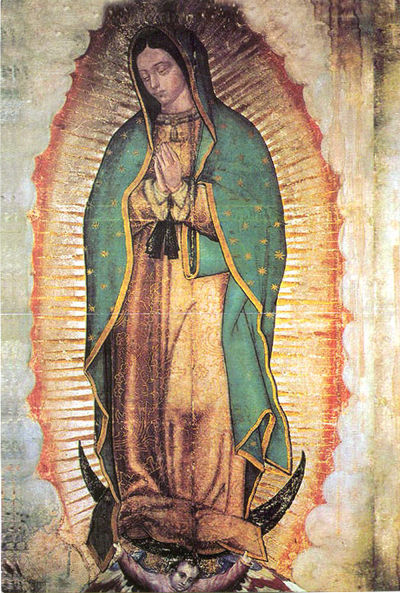 Our Lady of Guadalupe, in Mexico Our Lady of Guadalupe, in Mexico |
“In the fullness of time, we can be sure that Almighty God knew that the Islamic religion would pose a serious threat to Christianity. God also knew that the Spanish missionaries would face grave resistance in the ‘new world’ from the mighty Aztec Indians. The Aztecs worshipped an evil stone ‘serpent god’ that demanded human sacrifice. (Between 20,000 and 50,000 were sacrificed a year. The rituals included cannibalism of the victims' limbs. The early Mexican historian Ixtlilxochitl estimated that one out of every five children in Mexico were sacrificed.)
“However, with God all things are possible. Our Lady appeared to a humble Aztec Indian convert by the name of Juan Diego in 1531. When asked her name by Juan Diego, at the request of the local bishop, Our Lady's response, in the Aztec language, included the words ‘te coatlaxopeuh’ (pronounced: ‘te quatlasupe’) and meant “one who crushes the head of the stone serpent.’
“To Juan Diego and his fellow Aztecs, this revelation had great meaning, coupled with the miraculous image of Our Lady standing on top of a ‘crescent,’ the symbol of this evil serpent god. A tidal wave of conversions to Catholicism ensued. However, Bishop Zumarraga, who was from Spain, made what was no doubt a ‘heavenly mistake’ that one day may lead to the mass conversion of Moslems. To the Bishop's Spanish ears, Our Lady's Aztec name of ‘Te Quatlasupe’ sounded just like the name of the revered Madonna from Spain with the Islamic name, ‘Guadalupe.’ Hence, the bishop named the Mexican Madonna ‘Our Lady of Guadalupe.’ It is interesting that the ‘crescent’ is also the symbol for Islam.
“On October 7, 1571, a great victory over the mighty Turkish fleet was won by Catholic naval forces primarily from Spain, Venice, and Genoa under the command of Don Juan of Austria. It was the last battle at sea between ‘oared’ ships, which featured the most powerful navy in the world, a Moslem force with between 12,000 to 15,000 Christian slaves as rowers. Knowing that the Christian forces were at a distinct material disadvantage, the holy pontiff, St. Pope Pius V called for all of Europe to pray the Rosary for victory.
“We know today that the victory was decisive, prevented the Islamic invasion of Europe, and evidenced the Hand of God working through Our Lady. At the hour of victory, St. Pope Pius V, who was hundreds of miles away at the Vatican, is said to have gotten up from a meeting, went over to a window, and exclaimed with supernatural radiance: ‘The Christian fleet is victorious!’ and shed tears of thanksgiving to God. What you may not know is that one of three admirals commanding the Catholic forces at Lepanto was Andrea Doria. He carried a small copy of Mexico's Our Lady of Guadalupe into battle. This image is now enshrined in the Church of San Stefano in Aveto, Italy.
“At Fatima, Our Lady taught us to pray the Rosary every day. Heaven presented its peace plan at Fatima and truly gave us hope for the world. Conversions were promised at Fatima: the conversion of sinners; the conversion of Russia; and what also appears to be the conversion of Islam. Our Lady of the Rosary, pray for us!”
Father Cizik
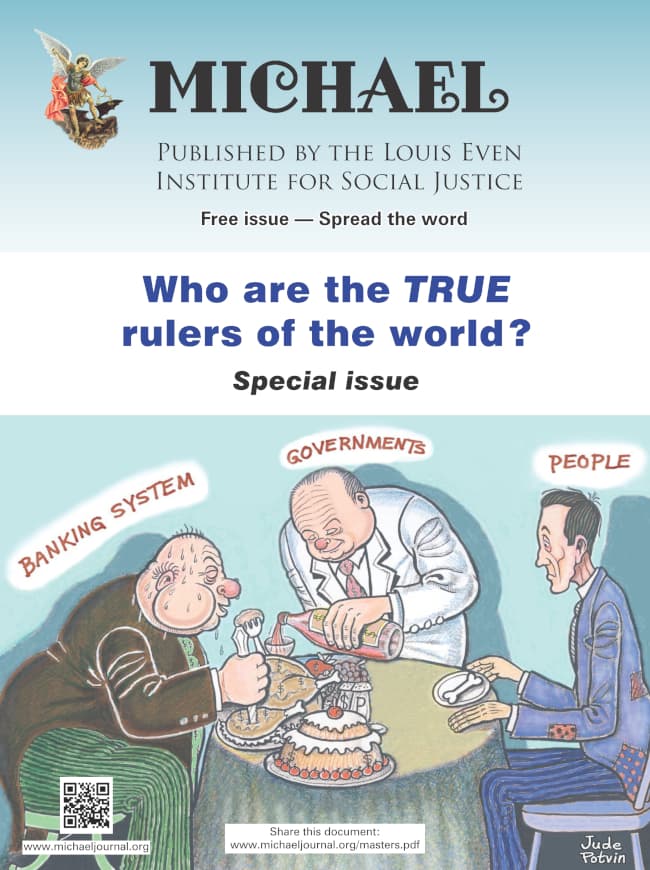 In this special issue of the journal, MICHAEL, the reader will discover who are the true rulers of the world. We discuss that the current monetary system is a mechanism to control populations. The reader will come to understand that "crises" are created and that when governments attempt to get out of the grip of financial tyranny wars are waged.
In this special issue of the journal, MICHAEL, the reader will discover who are the true rulers of the world. We discuss that the current monetary system is a mechanism to control populations. The reader will come to understand that "crises" are created and that when governments attempt to get out of the grip of financial tyranny wars are waged.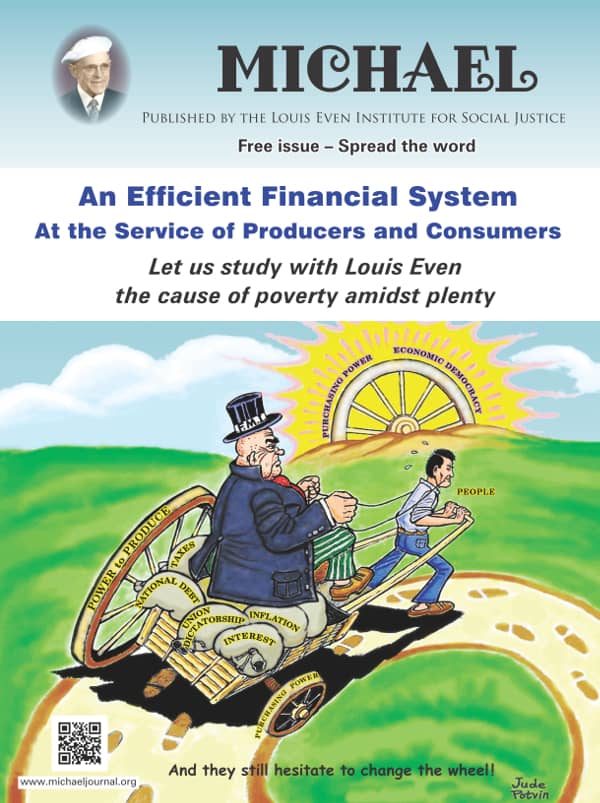 An Efficient Financial System, written by Louis Even, is for the reader who has some understanding of the Douglas Social Credit monetary reform principles. Technical aspects and applications are discussed in short chapters dedicated to the three propositions, how equilibrium between prices and purchasing power can be achieved, the financing of private and public production, how a Social Dividend would be financed, and, finally, what would become of taxes under a Douglas Social Credit economy. Study this publication to better grasp the practical application of Douglas' work.
An Efficient Financial System, written by Louis Even, is for the reader who has some understanding of the Douglas Social Credit monetary reform principles. Technical aspects and applications are discussed in short chapters dedicated to the three propositions, how equilibrium between prices and purchasing power can be achieved, the financing of private and public production, how a Social Dividend would be financed, and, finally, what would become of taxes under a Douglas Social Credit economy. Study this publication to better grasp the practical application of Douglas' work. 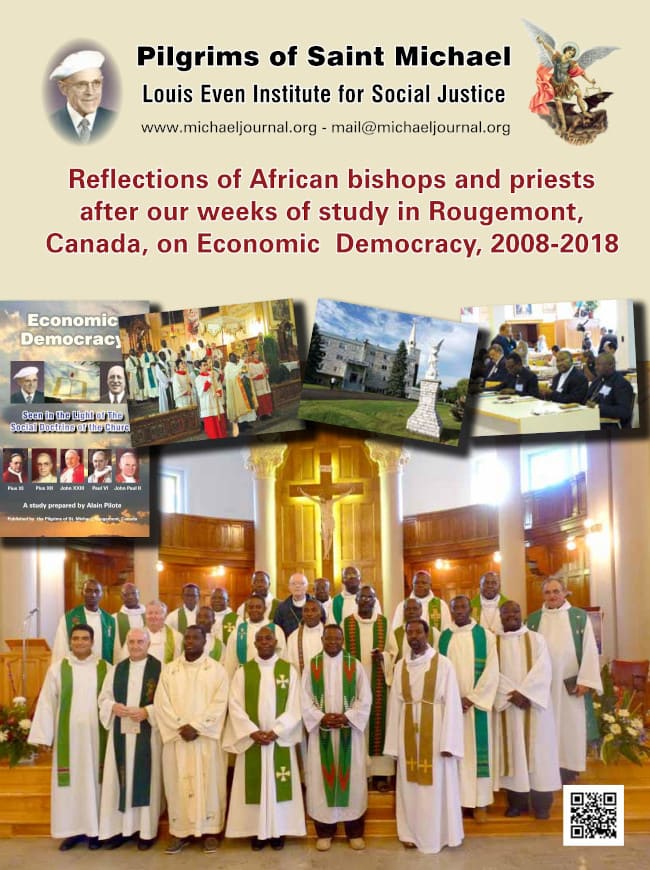 Reflections of African bishops and priests after our weeks of study in Rougemont, Canada, on Economic Democracy, 2008-2018
Reflections of African bishops and priests after our weeks of study in Rougemont, Canada, on Economic Democracy, 2008-2018 The Social Dividend is one of three principles that comprise the Social Credit monetary reform which is the topic of this booklet. The Social Dividend is an income granted to each citizen from cradle to grave, with- out condition, regardless of employment status.
The Social Dividend is one of three principles that comprise the Social Credit monetary reform which is the topic of this booklet. The Social Dividend is an income granted to each citizen from cradle to grave, with- out condition, regardless of employment status.Rougemont Quebec Monthly Meetings
Every 4th Sunday of every month, a monthly meeting is held in Rougemont.
Comments (1)
Gabriel
Reply